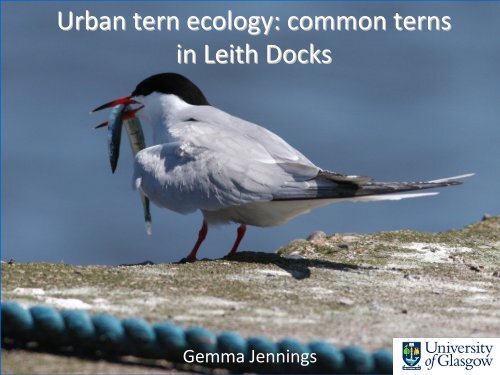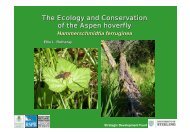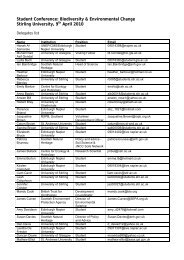An Urban Colony of Common Terns in Leith Docks
An Urban Colony of Common Terns in Leith Docks
An Urban Colony of Common Terns in Leith Docks
Create successful ePaper yourself
Turn your PDF publications into a flip-book with our unique Google optimized e-Paper software.
<strong>Urban</strong> tern ecology: common terns<br />
<strong>in</strong> <strong>Leith</strong> <strong>Docks</strong><br />
Gemma Jenn<strong>in</strong>gs
Overview<br />
•Firth <strong>of</strong> Forth population<br />
•Imperial Dock Lock Special Protection Area (SPA)<br />
•Forag<strong>in</strong>g ecology<br />
•Predation<br />
•Summary
<strong>Common</strong> terns <strong>in</strong> the Firth <strong>of</strong> Forth<br />
• Formerly found on natural islands: e.g. Fidra, Inchmickery<br />
• <strong>Leith</strong> colony grew from 50 pairs <strong>in</strong> 1971 to 732 pairs <strong>in</strong> 2009<br />
• <strong>An</strong>alysis <strong>of</strong> long term data suggests colonisation occurred as<br />
a result <strong>of</strong> relocation from natural islands<br />
• Decl<strong>in</strong>e <strong>of</strong> tern colonies on natural islands largely due to<br />
<strong>in</strong>creas<strong>in</strong>g gull numbers
<strong>Common</strong> terns <strong>in</strong> the Firth <strong>of</strong> Forth<br />
1200<br />
1000<br />
800<br />
600<br />
400<br />
200<br />
1969<br />
1971<br />
1973<br />
1975<br />
1977<br />
1979<br />
1981<br />
1983<br />
1985<br />
1987<br />
1989<br />
1991<br />
1993<br />
1995<br />
1997<br />
1999<br />
2001<br />
2003<br />
2005<br />
2007<br />
2009<br />
0<br />
<strong>Colony</strong> Size (number <strong>of</strong> breed<strong>in</strong>g pairs)<br />
Data courtesy <strong>of</strong> JNCC.<br />
Year<br />
<strong>Leith</strong> <strong>Docks</strong><br />
Inchmickery
Imperial Dock Lock SPA<br />
• Special Protection Area for the common tern s<strong>in</strong>ce 2004<br />
• 5% British population<br />
• Largest colony <strong>in</strong> Scotland
<strong>Leith</strong> <strong>Docks</strong><br />
Images: Forth Ports
•Fieldwork May‐August<br />
•732 breed<strong>in</strong>g pairs<br />
•M<strong>in</strong>imum 0.6 chicks/pair<br />
2009 Breed<strong>in</strong>g Season
Forag<strong>in</strong>g Ecology<br />
Where
Forag<strong>in</strong>g Routes
Number <strong>of</strong> terns us<strong>in</strong>g each sector<br />
*<br />
*<br />
* P
Height <strong>of</strong> flight paths <strong>in</strong> the docks<br />
Most birds fly below 20m<br />
Error bars: 95% CI<br />
A: 0‐10m B:>10‐20m C:>20m
Forag<strong>in</strong>g Areas
JNCC Mar<strong>in</strong>e SPA Work<br />
•Exist<strong>in</strong>g SPAs provide protection at breed<strong>in</strong>g colony<br />
•Mar<strong>in</strong>e SPAs would protect important areas at sea,<br />
i.e. feed<strong>in</strong>g sites<br />
•JNCC to recommend possible mar<strong>in</strong>e SPAs for common,<br />
arctic, little, sandwich and roseate terns<br />
•Funded by SNH<br />
•Species‐specific habitat suitability models us<strong>in</strong>g...<br />
‐ exist<strong>in</strong>g mar<strong>in</strong>e habitat data<br />
‐ at‐sea tern distribution data
JNCC Mar<strong>in</strong>e SPA Work<br />
Wilson, L.J., B<strong>in</strong>gham, C.J., Black, J., Kober, K., Lewis, M., Webb, A. and Reid, J.B. (2009) Identify<strong>in</strong>g<br />
important areas for mar<strong>in</strong>e terns. Unpublished JNCC 1 st <strong>in</strong>terim report, December 2009
Forag<strong>in</strong>g Ecology<br />
What
Feed<strong>in</strong>g observations<br />
1) Courtship feed<strong>in</strong>g: scan sampl<strong>in</strong>g, whole colony<br />
2) Chick feed<strong>in</strong>g: focal nest observations, 20 nests<br />
• Recorded prey type and size (bill lengths)
Courtship feed<strong>in</strong>g<br />
Clupeids/gadids = 64%<br />
…but mostly clupeids!<br />
Sandeel = 36%<br />
Chick rear<strong>in</strong>g<br />
Clupeids = 68% (68%)<br />
Sandeel = 16% (25%)<br />
Gadids = 16% (8%)<br />
N = 2978<br />
N = 325<br />
>60% clupeids
Predation
Predation<br />
Crows<br />
Herr<strong>in</strong>g gull<br />
Lesser black‐backed gull<br />
~1 chick every 2 hours<br />
> Specialists
Predation and development<br />
• Possible <strong>in</strong>crease <strong>in</strong> predators<br />
…number and diversity<br />
e.g. rats, foxes, cats, plus gulls/corvids<br />
Major threat <strong>in</strong>direct via impact on predatory species<br />
> Waste control<br />
> Habitat management
Summary<br />
• Recent colonisation from natural Forth islands<br />
• Tolerate general dock activity –but response depends on tim<strong>in</strong>g<br />
and nature <strong>of</strong> disturbance<br />
• Flight paths widespread across sea wall, mostly below 20m<br />
• Ma<strong>in</strong> feed<strong>in</strong>g areas <strong>in</strong> the Firth <strong>of</strong> Forth, with<strong>in</strong> 10km <strong>of</strong> colony<br />
• Generalists, but feed mostly on clupeids: would suggest good<br />
stocks nearby<br />
• Major impact <strong>of</strong> development <strong>in</strong> the area is likely to be <strong>in</strong>direct,<br />
via effect on predatory species
Thanks!<br />
• Pr<strong>of</strong>. Bob Furness<br />
• Dr Derek McGlashan<br />
• JNCC Mar<strong>in</strong>e SPA Team‐ L<strong>in</strong>da<br />
Wilson, Kerst<strong>in</strong> Kober, Craig<br />
Bloomer<br />
• Lothian R<strong>in</strong>g<strong>in</strong>g Group ‐ John<br />
Davies<br />
• Ia<strong>in</strong> Muir<br />
• Dr Duncan Smallman<br />
• L<strong>in</strong>dsay Henderson<br />
• Zara Gladman<br />
g.jenn<strong>in</strong>gs.1@research.gla.ac.uk







